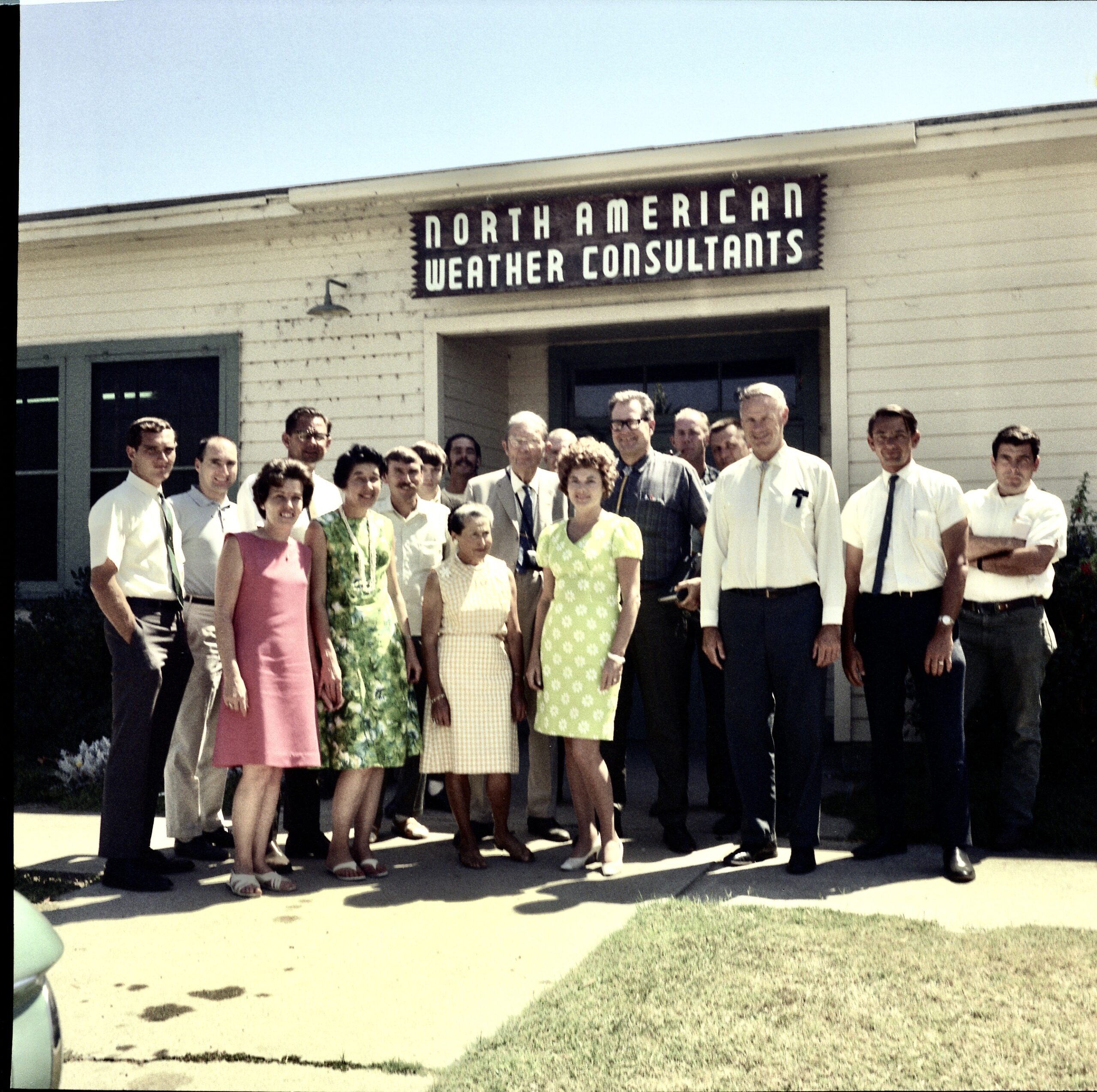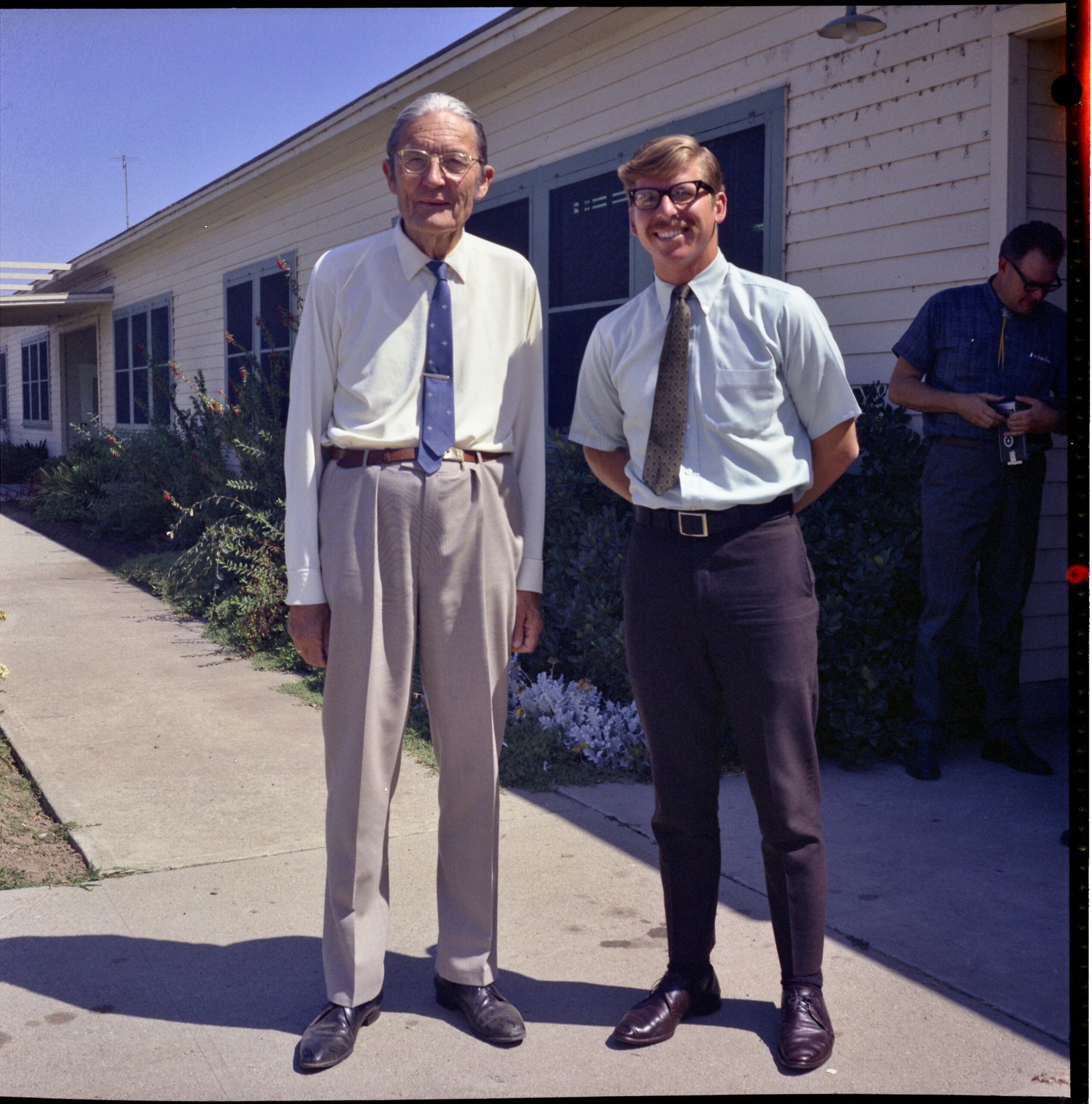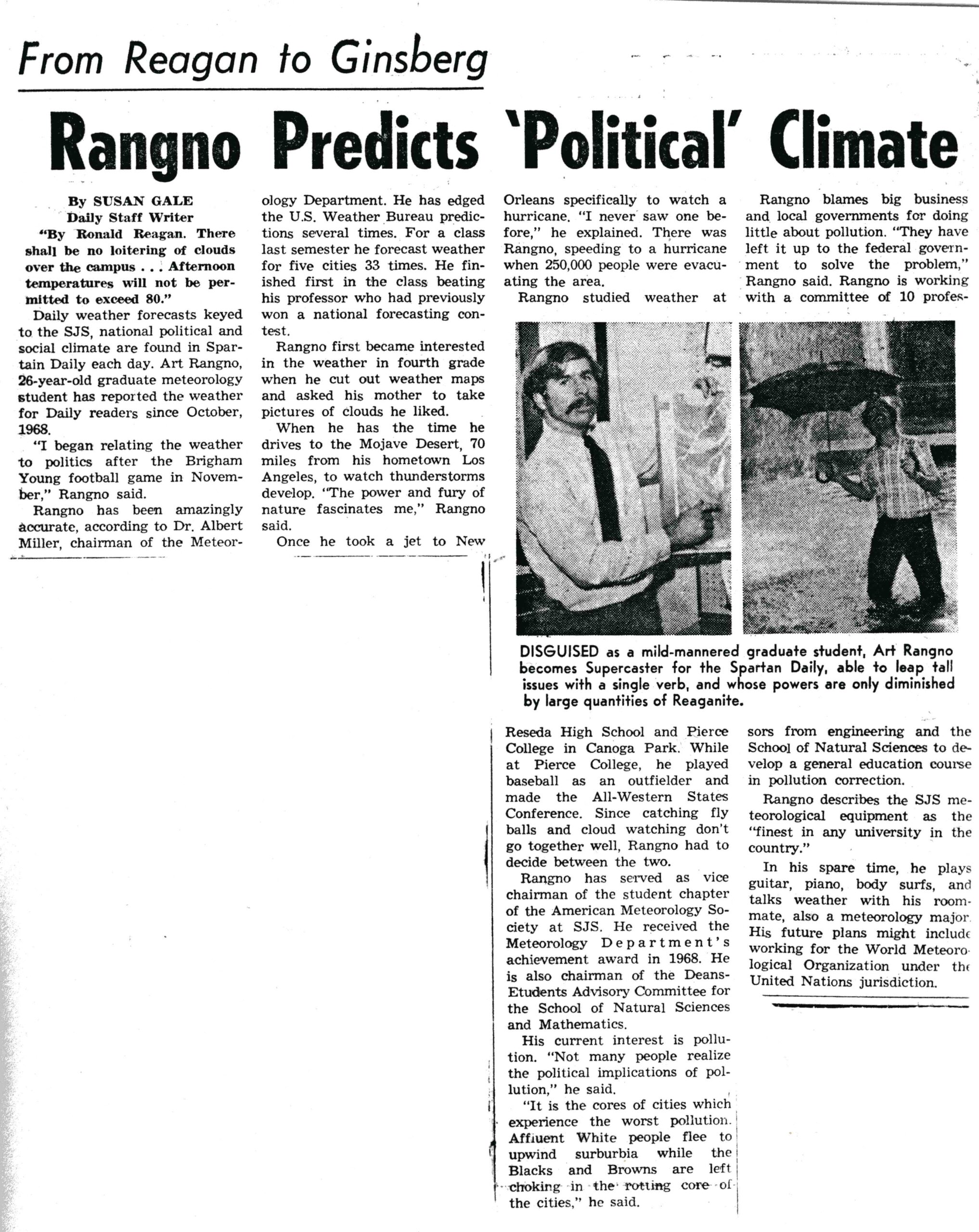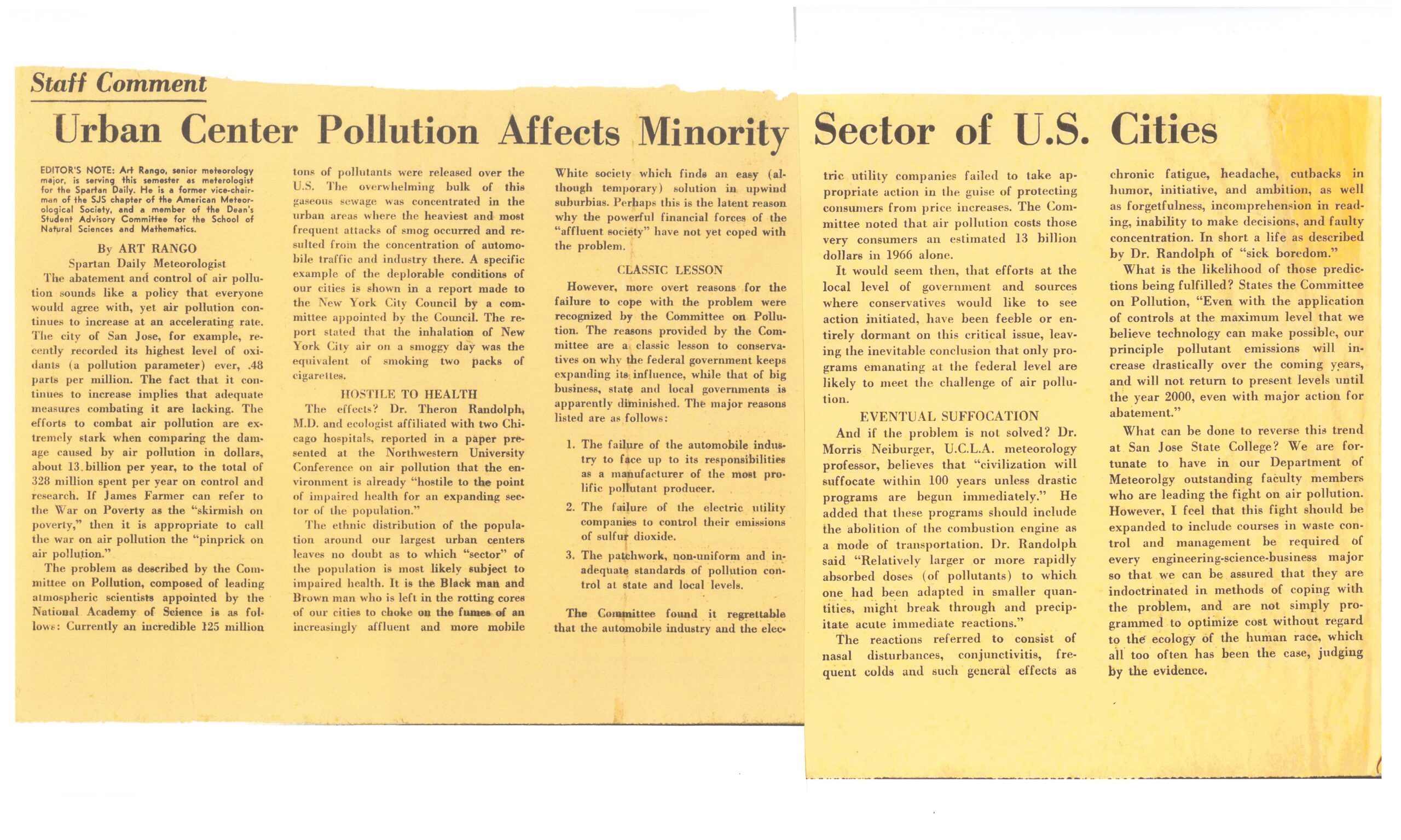This is a story about Joanne (Malkus) Simpson and our mutual study interest, Prof. Avraham “Abe” Gagin of the Hebrew University of Jerusalem, the leader of the world famed Israeli cloud seeding experiments that took place in the 1960s to 1970s. This is a story having irony. For more about Joanne Simpson and her major contributions to meteorology, see J. R. Fleming’s, “First Woman: Joanne Simpson and the Tropical Atmosphere”. She was a real superstar.
(https://www.amazon.com/First-Woman-Simpson-Tropical-Atmosphere/dp/0198862733).
My own modest claim to fame, partly for the work reported here:
washington.edu/…/two-uw-researchers-honored-by-un-for-excellence-in-weather-modification
Following the untimely passing of Professor Abe Gagin[1], Joanne Simpson stated that, “statues will be raised in many towns and halls of fame” in his memory due to his contributions to cloud seeding. Her testimonial appeared in the 1988 memorial issue to A. Gagin of the J. Weather Modification and is shown at the end of this account. The memorial issue of that journal is here:
(https://journalofweathermodification.org/index.php/JWM/issue/view/38/_24)[2]
As a measure of Prof. Gagin’s stature when he passed and why statue building might be considered for him, the October 1989 J. of Appl. Meteor. also issued a memorial volume to Prof. Gagin in due to his work in cloud seeding. The preface to that memorial issue, written by Arnett S. Dennis, a former co-author of Joanne’s, is also shown at the end of this account. Hardly any scientists are tributed by memorial issues of journals, much less, two! Prof. Gagin’s frequent co-author in describing the results of the Israeli cloud seeding experiments, Prof. Jehuda Neumann, was ALSO tributed with a memorial issue of the J. Appl. Meteor. when he passed ten years later.
Prof. Gagin passed in September 1987 at the untimely age of 54, a few months after learning in a letter from Prof. Peter Hobbs that my manuscript, “Rain from clouds with tops warmer than -10°C in Israel,” had been accepted for publication by the Quart. J. Roy. Meteor. Soc. This paper showed that the clouds of Israel were completely different than the ones Prof. Gagin was repeatedly describing in the literature and at conference.
At the same time of his passing, Prof. Gagin was also being pressured by his own chief meteorologist, Mr. Karl Rosner, to publish the previously omitted data for the south target of Israel-2. This was the 2nd randomized cloud seeding experiment that was conducted from the 1969/70 through 1974/75 Israeli rain seasons. The reporting of Israel-2 had been confined to the north target where there was an appearance that cloud there had pretty much replicated what had been reported in ALL of Israel-1.
The testimonials to A. Gagin by many leading scientists in the cloud seeding domain were omitted in the digital version of the 1988 JWM volume when digitizing was done many years later but can be found at the end of this story.
My one and only in-person interaction with Joanne Malkus Simpson: “Go into journalism not meteorology.”
I met with Joanne (Malkus) Simpson in January 1963 at UCLA. She had been brought to my attention when she had been named, Los Angeles Times “Woman of the Year.” I was meeting with her, a professor of meteorology, to try and convince her that as a 20-year old junior college student, I was worthy of getting into the UCLA meteorology program even though I did not have a high enough grade point average to do so. UCLA required a minimum of 2.4 and mine was barely above 2.0000x. And I had to repeat all but one of my calculus and physics classes at Pierce Junior College. I had spent too much time playing and practicing for intercollegiate baseball, but I also had no natural aptitude for physics and calculus.
UCLA was the only school offering courses for a degree in meteorology in California in 1963, and that’s why I went there to meet with Dr. Malkus, as she was known as then. It seemed like UCLA offered the only hope of achieving my dream to become a meteorologist. I thought explaining my fanaticism about weather would do the trick. For example I had gone to Louisiana and ended up near Galveston, Texas, chasing Hurricane Carla in September 1961, and chased numerous thunderstorms in the Southern California desert during the summers.
Some early background that if told to Joanne, would convince her I was worthy of UCLA’s program
I began collecting weather maps out of the Los Angeles Daily News when I was in the 4th grade. (Thank you, Mr. Borders and Mr. De la Gega, my 4th and 5th grade teachers, for encouraging my budding interest!). Below a sample of a real weather map with isobars from the Los Angeles Daily News for December 26, 1951. How exciting is this?
Too, I was subscribing to the “Daily Weather Map” by the time I was ten years old. By the time I was 13 years old, I was subscribing to the Monthly Weather Review and several states’ government, “Climatological Data” from NOAA. (Well, my mom subscribed for me.)
I crazily thought that telling Joanne about all this would get me in to UCLA sans the grade requirement.
“The Meeting”
The first thing Joanne Malkus asked me when she kindly took a minute out of her busy schedule (I had made no appointment) was how my grades were in math and physics. I told her I got “Cs” but did not reveal to her that those “Cs” were on the second try! She then asked me, “How are your grades in the humanities?” “B’s.” With my answers to but two questions, Prof. Malkus then advised me to give up the thought of becoming a meteorologist, and become, perhaps,, “a journalist and write about weather.” And that was the end of the meeting; in less than five minutes I was advised to give up a life-long dream.
Yes, I “held myself back,” to repeat courses in math and physics, and in doing so lost my collegiate baseball eligibility. Who would do this?But.. that stubbornness, to keep at it, not giving up my dream, turned out to be key to my whole life. But perhaps it could be seen as a character flaw, too?
Joanne Malkus assessment of my potential as a student in the UCLA meteorology program was, in fact, “spot on.”
Thank you, Joanne (Malkus) Simpson.
Why?
In retrospect, I never could have gotten through the highly theoretical program at UCLA in those days, a program that featured Morton Wurtele, Yale Mintz, Morris Neiburger, Jörgen Holmboe, Zdenek Sekera, James Edinger, and Jacob Bjerknes, the latter who had founded the Department in 1940. Fjørtoft, a visiting Norwegian professor of meteorology, or possibly Holmboe, was slinging vector equations across a blackboard as I walked down the hall following my meeting with Prof. Malkus. At UCLA in those days, one would have walked the halls with giants. A few years earlier I had tried to get the autograph of Prof. Bjerknes at UCLA since meteorologists like him were to me, like baseball superstars to other, “normal” kids. Prof. Bjerknes was not in his office that day, but rather there was a sign said he was, “emeritus,” which I took to mean he was especially good as a scientist, not that he was retired.
After my 1963 meeting with Joanne Malkus I was angry and hurt and promptly went to the UCLA bookstore and bought one of the books they were using in their meteorology program, I was that mad. The book? “Introduction to Theoretical Meteorology” by Seymour Hess. I stopped reading it after a day or two. It had too many equations.
It took me more than 25 years to realize that Joanne Malkus Simpson had saved me from myself. I wrote her a note thanking her for her keen assessment in the early 1990s. She did not reply.
Life After “The Meeting”
In the spring of 1963 I had lucked out and gotten a job as a “research analyst” at Rocketdyne in their H-1 rocket group in the Simi Hills above the San Fernando Valley. Rocketdyne was a division of North American Aviation. By mid-1964, I was “suddenly” married and had a son. Becoming a meteorologist was slowly slipping off the radar, but I loved my job at Rocketdyne (about Rocketdyne) and the young, great engineers that led my group, like Wayne Littles who later became the 8th director of the NASA Marshall Space Flight Center in Huntsville. They set great examples as engineers and leaders.
Rocketdyne’s Simi Hills test division where I worked, had a weather forecast office and I bugged the guys there, Joe Glantz (former State Climatologist for California) and Hank Weiss, virtually EVERY lunch time during the winter rain season. We talked “progs” such as they were then.
I also started on another path toward being a meteorologist while married, still not giving up on my goal. I took two correspondence courses in meteorology from Penn State University (graded by A. K. Blackadar and F. B. Stephens).
When my marriage was going on the rocks in the mid -1960s due to my immaturity, I learned that San José State College had started a program in meteorology. I applied and got accepted even with my crummy grade point average from junior college. It was an exciting time for me to meet, for the first time in my life, other weather-centric guys like me when I arrived at SJS in the spring of 1967. One of them, Bill Hall, was to become something of a modeling superstar at the National Center for Atmospheric Research. Byron Marler, who ended up with PG&E, became a life long friend.
I also became friends with the chair of the Meteorology Department in those days, Dr. Albert Miller. He helped me tremendously by hiring me as a student assistant while I was an undergraduate, and later, as a graduate assistant in the synoptic lab. Dr. Miller was like a 2nd dad to me. Also key to being able to continue at San Jose State was my former Rocketdyne supervisor, A. Dan Lucci, who re-hired me as a summer employee at Rocketdyne in 1967 after my first semester at San Jose State.
Another person whom I became good friends with at SJS due to working together, was C. Donald Ahrens, who was to go on and write the most popular meteorology book for 101 college classes in the nation, “Meteorology Today” and several other books. His wife was to type the first chapter of his Meteorology Today book on my very own Hermes 3000 manual typewriter!
Don and I also worked together on tetroon (constant level balloon) paths in the Bay Area that disclosed where the onshore maritime air was going. We worked in a corrugated metal building next to the football stadium far from the meteorology department. To pass the otherwise tedious time, we had KGO-FM’s no commercials, top 40 radio station with DJ “Brother John” blaring. And, we would break into song! We really liked the Four Seasons, Western Union, by the Five Americans, and so many others that we sang to many of them, harmonizing, while our heads were down plotting tetroon paths. I still smile thinking of those days.
In the summer of 1968, I worked for non-other than North American Weather Consultants under CEO, Robert D. Elliott. That summer Tor Bergeron came to visit! For those readers who remember NAWC in Goleta, California, here’s the photo I took of the whole gang, Elliott, Bergeron, Keith Brown, Russ and Elona Shaefer, John Walter and others whose names I can’t bring to the “surface:”
 I’ve never had a job I loved as much as that summer one at NAWC, or people I had so much in common with there. I also had a chance to meet the head of NAWC, the famous Robert D. Elliott, whom I came to admire so much while at NAWC. My assignment at NAWC was mainly to draw weather maps of frontal systems coming into southern California and “lake effects” for the Great Salt Lake in winter. I was in heaven.
I’ve never had a job I loved as much as that summer one at NAWC, or people I had so much in common with there. I also had a chance to meet the head of NAWC, the famous Robert D. Elliott, whom I came to admire so much while at NAWC. My assignment at NAWC was mainly to draw weather maps of frontal systems coming into southern California and “lake effects” for the Great Salt Lake in winter. I was in heaven.
Back at San Jose State in the fall of 1968, I started a tiny forecast blurb on the front page of the Spartan Daily. It devolved into political satire at the suggestion of the Daily’s editor after one my forecasts, “…with the stratus, not the campus, burning off by noon.” There had been some fires set in trash cans by protestors the day before on the San Jose State campus. The Daily editor said I should do more of that, and off I went into some pretty lame stuff. Oh, well; “let’s move along now, nothing to see here.”
I also began to write opinion pieces in the San Jose State Daily, mostly due to the encouragement of Prof. Phil Wander, my speech teacher. I deem him one of the most important influences in my life. He thought I had something to say, such as this from a talk I gave in his class:
I was also writing articles for the college paper on ending student funding of intercollegiate athletics due to Governor Reagan’s budget cuts, pollution and the effects on minorities (above), suggesting parking costs be based on the number of people in the car, and on the war in Vietnam, the latter as many others were. My SJS experience is pretty much reprised in the “friendly” article below, miniaturized for the sake of humility, of which, I probably don’t have enough of:
I graduated from modest San José State College, as it was known then, with a Bachelor of Arts degree in meteorology in January 1969. My grades, for so much effort I put into my meteorology classes with lots of math were, nevertheless, mostly mediocre except in synoptic classes. However, I was a good weather map drawer and getting A’s in synoptic classes really helped raise my grade point average.
Perhaps due to writing topical articles in the SJS Spartan Daily, I received the Meteorology Department’s Achievement Award when I graduated in January 1969. Egad. I was never sure I deserved it with big hitters and great students like future NCAR cloud modeler, Bill Hall, and other top students like Norm Hoffman, Chris Fontana, in my class getting “A’s.”
An example of over valuing my satirical talent that were on display in the Spartan Daily weather forecasts, in the summer of 1969, I went to KRLA-AM in Los Angeles to suggest that I could be a weather forecaster for them. KRLA was a top 40 station whose news team suddenly began doing news satire in 1968, and they dared to offend. What they did was astounding to me and was even noted in Time magazine!
I wondered if I could be their weather forecaster, and maybe chip in to the their comedy team, later called, “The Credibility Gap”. I showed a page of my Spartan Daily forecasts to a young Harry Shearer, a member of the KRLA satirical news team. He quickly glanced across them and summarized his thoughts on them like this; “They’re not that funny, are they?” End of interview.
I hung around San Jose State attending graduate classes until the spring of 1970. At that time I was offered a job as an assistant weather forecaster with the nation’s largest ever randomized mountain cloud seeding experiment headquartered in Durango, CO,. Funded by the Bureau of Reclamation, it was called the Colorado River Basin Pilot Project (CRBPP). I was hired after being interviewed by J. Owen Rhea of E. G. & G, Inc. in San Jose! E. G. & G., Inc. had just been selected over North American Weather Consultants (NAWC) as the seeding contractor for the CRBPP. Owen was going to be the lead forecaster under Paul T. Willis, the E. G. & G., Inc., Project Manager.
I really didn’t belong in grad school, either; too many equations. Nevertheless, it was hard to leave the excitement of SJS of those days. SJS track stars, Tommy Smith and John Carlos had just drawn national attention to SJS, that season’s NCAA track champion, at the 1968 Olympics in Mexico City with their raised, “black power” fists.
I also received a job offer from NAWC in Goleta, CA, at that time, too. I did not know until decades later that they were finalists in bidding on the same contract that E. G. & G., Inc. had won from the Bureau of Reclamation for the seeding and forecasting operations for the Colorado River Basin Pilot Project.
But the job in Durango seemed so important and exciting; I was going to be a part of a giant scientific experiment to see if cloud seeding worked and so that’s where I went. The thought that it was exciting that I would also be living in a new climate after a lifetime in California’s.
1970: It was now seven years since Joanne had advised me to give up the idea of being a meteorologist. And now I was going to enter a field that she was a top expert in; weather modification by cloud seeding.

